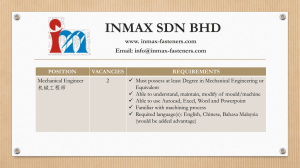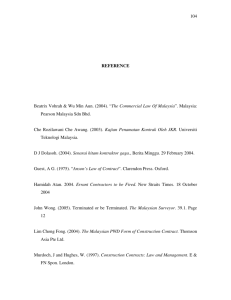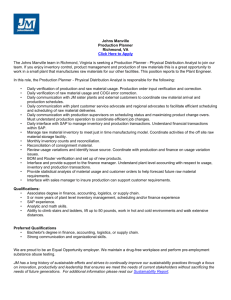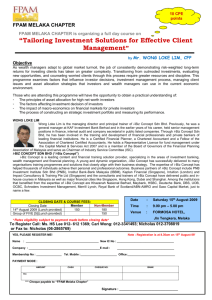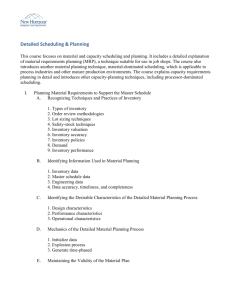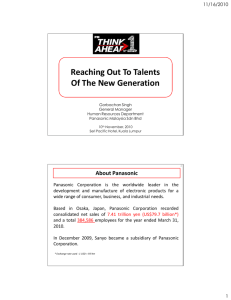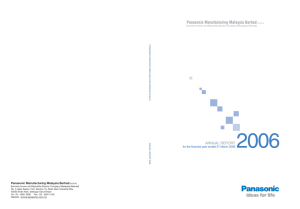Panasonic Appliances Air- Conditioning Malaysia Sdn. Bhd. g y
advertisement
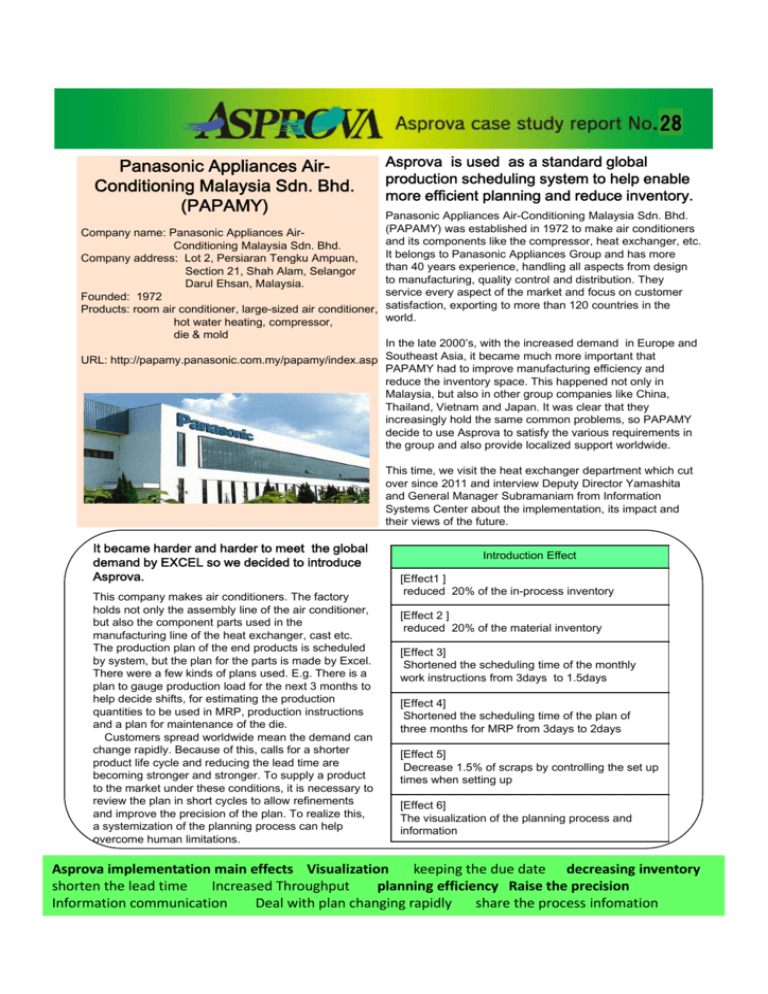
28 Panasonic Appliances AirConditioning g Malaysia y Sdn. Bhd. (PAPAMY) Asprova is used as a standard global production scheduling system to help enable more efficient planning and reduce inventory inventory. Panasonic Appliances Air-Conditioning Malaysia Sdn. Bhd. (PAPAMY) was established in 1972 to make air conditioners Company name: Panasonic Appliances Airand its components like the compressor, heat exchanger, etc. Conditioning Malaysia Sdn. Bhd. It belongs to Panasonic Appliances Group and has more Company address: Lot 2, Persiaran Tengku Ampuan, than 40 years experience, handling all aspects from design Section 21, Shah Alam, Selangor to manufacturing, quality control and distribution. They Darul Ehsan, Malaysia. service every aspect of the market and focus on customer Founded: 1972 Products: room air conditioner,, large-sized g air conditioner,, satisfaction, exporting to more than 120 countries in the ld world. hot water heating, compressor, die & mold In the late 2000’s, with the increased demand in Europe and URL: http://papamy.panasonic.com.my/papamy/index.asp Southeast Asia, it became much more important that PAPAMY had to improve manufacturing efficiency and reduce the inventory space. This happened not only in Malaysia, but also in other group companies like China, Thailand, Vietnam and Japan. It was clear that they increasingly hold the same common problems, so PAPAMY decide to use Asprova to satisfy the various requirements in the group and also provide localized support worldwide. This time, we visit the heat exchanger department which cut over since 2011 and interview Deputy Director Yamashita and General Manager Subramaniam from Information Systems Center about the implementation, its impact and their views of the future. It became harder and harder to meet the global demand by EXCEL so we decided to introduce Asprova. This company makes air conditioners. The factory holds not only the assembly line of the air conditioner, but also the component parts used in the manufacturing line of the heat exchanger, cast etc. The production plan of the end products is scheduled by system, but the plan for the parts is made by Excel. There were a few kinds of p plans used. E.g. g There is a plan to gauge production load for the next 3 months to help decide shifts, for estimating the production quantities to be used in MRP, production instructions and a plan for maintenance of the die. Customers spread worldwide mean the demand can change rapidly. Because of this, calls for a shorter product life cycle and reducing the lead time are becoming stronger and stronger. To supply a product to the market under these conditions, it is necessary to review the plan in short cycles to allow refinements and improve the precision of the plan. To realize this, a systemization of the planning process can help overcome human limitations. Introduction Effect [Effect1 ] reduced 20% of the in-process inventory [Effect 2 ] reduced 20% of the material inventory [Effect 3] Shortened the scheduling time of the monthly work instructions from 3days to 1 1.5days 5days [Effect 4] Shortened the scheduling time of the plan of three months for MRP from 3days to 2days [Effect 5] Decrease 1.5% of scraps by controlling the set up times when setting up [Effect 6] The visualization of the planning process and information Asprova implementation main effects Visualization keeping the due date decreasing inventory shorten the lead time Increased Throughput planning efficiency Raise the precision Information communication Deal with plan changing rapidly share the process infomation ■User Information System Center Khamarul Safis Bin Ismai Au Kin Swee K.Subramaniam Satoru Yamashita Ong Eng Kee (from left) Heat Exchanger Section Badrulhisyam Kamarudin Nahar Azman Abu Yamin Selamat (f (from left) l ft) ■distributor Data Collection Systems (M) Sdn Bhd. URL: http://www.dcs‐group.jp/ It is important to maintain the master data in order to use the scheduling system efficiently To use a scheduling system, it at least needs information including items, item composition, p , resource constraints,, and resource capabilities. In the company, the mission-critical system has used SAP for 10 years to managed the items and the item composition. On the other hand, resource constraints and resource capabilities are maintained by other MES systems. So an interface between Asprova with SAP & MES was programmed to prevent the duplicate maintenance of the master data. The scheduling result is used by suppliers as the delivery instruction and the manufacturing department as the work instruction. When asked,“Are you satisfied with Asprova’s result ?” Subramaniam said “We review the master data if we’re not satisfied. It doesn’t work well if the master data is not reliable”. It is common that continuous maintenance is difficult for the factory in Southeast Asia and it is natural. The company recognizes the importance and effect of master data maintenance from the experience of the SAP introduction. And Yamashita said “the the manager is a member who experienced the SAP introduction project more than ten years ago. In Southeast Asia, it is said the job turnover rate is high, but he has worked passionately for the company for a long time. I think it is because there is history of advancement of the business in Malaysia for over 40 years”. The information systems section has over 20 persons, but there is only one Japanese expatriate. Localization of the managers is progressing and it has become an independent factory. Asprova Corporation Location: Gotanda TG Building 3F 3F, 7-9-2 7 9 2 Nishigotanda Shinagawa-ku, Tokyo 141-0031 Japan Tel: 03-6303-9933 Fax: 03-6303-9930 Web: http://www.asprova.com/ The future view: Auto-Scheduling of die maintenance The dies will break if not maintained regularly. This can cause productivity to fall. As such, it is necessary to make a die maintenance plan with high precision. Against this requirement, the company is considering using the “event option” to produce the maintenance plan automatically using Asprova. This is also one of the reasons Asprova was chosen. Development of other production sections It took 10 months to implement Asprova in the heat exchanger section which covered the first implementation and the programming of the interface. The skills, the interface and the know-how were prepared through this experience experience. About the future, Subramaniam said, “we are satisfied with the results of Asprova in the heat exchanger section. We will increase its precision and at the same time, deploy Asprova for the press and other components sections, etc. We hope to get the same effect as the heat exchanger”. And it is progressing i now. (Date:Dec 10th 2013)
